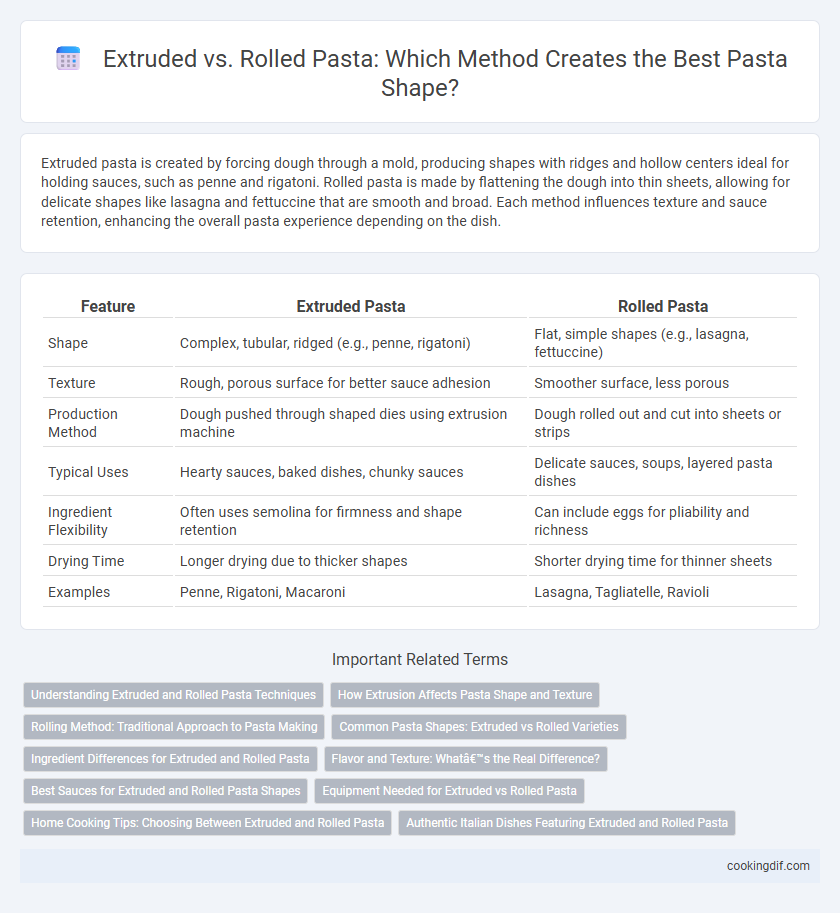Extruded pasta is created by forcing dough through a mold, producing shapes with ridges and hollow centers ideal for holding sauces, such as penne and rigatoni. Rolled pasta is made by flattening the dough into thin sheets, allowing for delicate shapes like lasagna and fettuccine that are smooth and broad. Each method influences texture and sauce retention, enhancing the overall pasta experience depending on the dish.
Table of Comparison
| Feature | Extruded Pasta | Rolled Pasta |
|---|---|---|
| Shape | Complex, tubular, ridged (e.g., penne, rigatoni) | Flat, simple shapes (e.g., lasagna, fettuccine) |
| Texture | Rough, porous surface for better sauce adhesion | Smoother surface, less porous |
| Production Method | Dough pushed through shaped dies using extrusion machine | Dough rolled out and cut into sheets or strips |
| Typical Uses | Hearty sauces, baked dishes, chunky sauces | Delicate sauces, soups, layered pasta dishes |
| Ingredient Flexibility | Often uses semolina for firmness and shape retention | Can include eggs for pliability and richness |
| Drying Time | Longer drying due to thicker shapes | Shorter drying time for thinner sheets |
| Examples | Penne, Rigatoni, Macaroni | Lasagna, Tagliatelle, Ravioli |
Understanding Extruded and Rolled Pasta Techniques
Extruded pasta is created by pushing dough through shaped holes in a die, resulting in intricate, textured shapes like penne and rigatoni that hold sauces effectively. Rolled pasta involves flattening the dough into thin sheets, which are then cut into shapes like fettuccine or lasagna, offering a smooth surface ideal for delicate sauces. These distinct techniques influence pasta texture and sauce adherence, impacting the overall culinary experience.
How Extrusion Affects Pasta Shape and Texture
Extruded pasta shapes are created by forcing dough through molds, resulting in consistent, uniform shapes with porous surfaces that better hold sauces. The extrusion process influences texture by introducing micro-roughness, enhancing sauce adhesion and creating a firmer bite compared to rolled pasta. This method is ideal for complex shapes like penne or rigatoni, while rolled pasta tends to produce smoother, flatter varieties such as lasagna or fettuccine.
Rolling Method: Traditional Approach to Pasta Making
The rolling method, a traditional approach to pasta making, produces smooth and thin sheets ideal for delicate shapes like lasagna and fettuccine. Unlike extruded pasta, rolled pasta has a uniform texture that allows for even cooking and better sauce adherence. This technique relies on gradual thinning using rolling pins or machines, preserving the dough's elasticity and resulting in tender, silky pasta.
Common Pasta Shapes: Extruded vs Rolled Varieties
Extruded pasta, produced by forcing dough through molds, features shapes like penne, rigatoni, and fusilli that provide grooves and ridges ideal for holding sauces. Rolled pasta, typically made by sheet-forming and cutting, includes varieties such as fettuccine, lasagna, and pappardelle, characterized by smooth surfaces and flat or ribbon-like shapes. Choosing between extruded and rolled pasta depends on desired texture and sauce pairing, with extruded pasta excelling in capturing thicker sauces and rolled pasta often preferred for lighter, cream-based dishes.
Ingredient Differences for Extruded and Rolled Pasta
Extruded pasta, crafted by forcing dough through shaped dies, typically uses durum wheat semolina or flour with high protein content to maintain shape and texture during extrusion. Rolled pasta dough often incorporates softer wheat flours such as all-purpose or 00 flour, combined with eggs to enhance pliability and smoothness for thin, delicate sheets. The ingredient variations between extruded and rolled pasta doughs significantly influence the final texture and ability to hold sauce.
Flavor and Texture: What’s the Real Difference?
Extruded pasta, shaped by forcing dough through bronze dies, develops a rough texture that holds sauce better and enhances flavor absorption. Rolled pasta, made by passing dough through smooth rollers, creates a sleek, tender surface ideal for delicate sauces and lighter dishes. Texture differences between extruded and rolled pasta directly influence mouthfeel and sauce pairing, shaping culinary experiences based on desired flavor intensity and pasta consistency.
Best Sauces for Extruded and Rolled Pasta Shapes
Extruded pasta, characterized by its porous texture from being pushed through bronze dies, excels in holding chunky sauces like ragu, pesto, or meat-based mixtures. Rolled pasta, typically smooth and delicate such as lasagna sheets or tagliatelle, pairs best with velvety, cream-based sauces or light tomato sauces that complement its tender structure. Choosing the right sauce enhances flavor absorption and texture harmony in dishes featuring extruded or rolled pasta varieties.
Equipment Needed for Extruded vs Rolled Pasta
Extruded pasta requires specialized equipment such as a pasta extruder, which uses a die to shape dough through precise pressure and temperature control, enabling complex shapes like rigatoni or penne. Rolled pasta is made using rolling machines or pasta rollers that flatten the dough into sheets before cutting, suitable for broader shapes like lasagna or fettuccine. Extrusion demands more advanced mechanical components and maintenance, while rolling relies on simpler, manual or semi-automatic equipment.
Home Cooking Tips: Choosing Between Extruded and Rolled Pasta
Extruded pasta, shaped by forcing dough through specialized dies, is ideal for sturdy varieties like penne and rigatoni, offering a firm texture that holds sauces well. Rolled pasta, crafted by flattening dough into thin sheets, suits delicate forms such as fettuccine and lasagna, providing a tender bite perfect for light, creamy sauces. Home cooks should select extruded pasta for robust dishes requiring texture and rolled pasta for recipes emphasizing softness and subtle sauce absorption.
Authentic Italian Dishes Featuring Extruded and Rolled Pasta
Authentic Italian dishes showcase the distinct textures and shapes achieved through extruded and rolled pasta methods, with extruded pasta like penne and rigatoni featuring ridged surfaces that hold rich sauces, perfect for hearty ragus in Emilia-Romagna cuisine. Rolled pasta, exemplified by delicate sheets in lasagna and fresh tagliatelle, offers a smooth texture ideal for light, creamy sauces typical of Tuscany and Lombardy. Understanding these traditional techniques enhances the culinary experience, reflecting regional Italian flavors and cooking styles.
Extruded vs rolled for pasta shape Infographic

 cookingdif.com
cookingdif.com